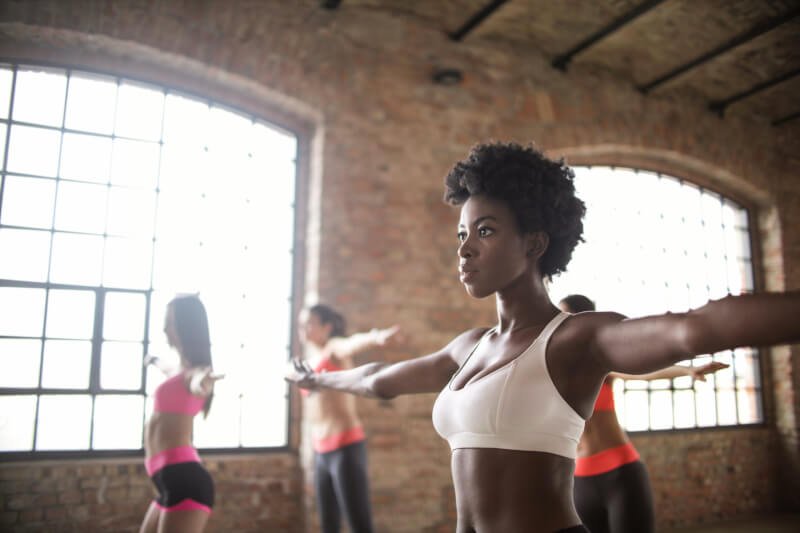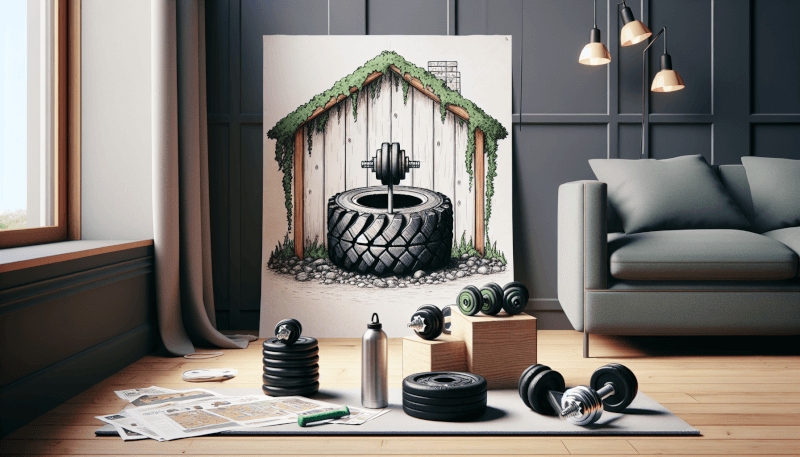Thinking about starting your own home gym but don’t want to spend a fortune on expensive equipment? Look no further! In this article, you’ll discover the secrets of building your own DIY home gym equipment. From easy-to-make dumbbells to creative resistance bands, we’ve got you covered. So, grab your tools and get ready to level up your workout routine without breaking the bank. It’s time to get creative and build the home gym you’ve always dreamed of. Let’s dive in!

Why Build a DIY Home Gym?
Benefits of a DIY Home Gym
Building a DIY home gym offers numerous benefits that can greatly enhance your fitness routine. One of the primary advantages is the cost savings. Instead of paying for a gym membership, you can invest that money into purchasing your own equipment and create a personalized gym experience at home. Additionally, building your own home gym gives you the opportunity to customize the space and equipment according to your specific needs and preferences. Whether you prefer strength training, cardio workouts, or a combination of both, a DIY home gym allows you to tailor the environment to your unique fitness goals.
Cost Savings
One of the main reasons people opt to build a DIY home gym is to save money in the long run. Gym memberships can be expensive, and those costs can add up over time. By investing in your own equipment, you eliminate the need for monthly or annual fees. While the initial investment may seem significant, it is a one-time expense that pays for itself over time. Additionally, purchasing used equipment or building your own can be more cost-effective than buying brand new gym equipment. With a little research and creativity, you can build a fully equipped home gym without breaking the bank.
Customization
Another advantage of building your own DIY home gym is the ability to customize the space and equipment to suit your preferences. Commercial gyms may have a wide variety of equipment, but they may not have exactly what you need or want. When creating your own gym at home, you have complete control over the equipment and layout. You can choose the specific machines, weights, and accessories that align with your fitness goals and interests. This level of customization allows you to create a gym environment that is motivating, efficient, and tailored to your specific needs.
Choosing the Right Space
Determining Available Space
Before setting up a DIY home gym, it is important to assess the available space in your house or apartment. Take a look at different areas such as spare rooms, basements, garages, or even an outdoor space. Consider the dimensions, layout, and access to power sources. Take measurements to ensure that the equipment you plan to purchase or build will fit comfortably in the chosen space. It is also essential to consider any potential limitations, such as low ceilings or narrow doorways, that may affect the type and size of equipment you can install.
Considering Weight and Noise
When selecting the space for your DIY home gym, it is important to consider the weight of the equipment you plan to install. Certain floors or structures may not be suitable for heavy equipment, as they could cause damage or pose a safety risk. Additionally, take into account the noise level. If you live in an apartment or have neighbors in close proximity, choose a space that minimizes the impact of noise disturbances. Consider adding soundproofing materials or selecting equipment that produces less noise during use.
Ventilation and Lighting
Proper ventilation and lighting are essential for a comfortable and inviting DIY home gym. Ensure that the chosen space allows for adequate airflow to prevent the buildup of heat and humidity. Good air circulation not only improves comfort but also helps maintain a healthy and hygienic workout environment. Adequate lighting is crucial for safety and visibility during workouts. Natural light or well-placed artificial lighting can enhance the overall experience, making your home gym a more enjoyable place to exercise.
Essential Equipment for a DIY Home Gym
Dumbbells and Barbells
Dumbbells and barbells are essential pieces of equipment for any DIY home gym. They are versatile, allowing you to target different muscle groups and adjust the weights according to your strength level and fitness goals. Dumbbells are ideal for exercises like bicep curls, shoulder presses, and lunges, while barbells are great for compound movements like squats, bench presses, and deadlifts. Consider purchasing a set of adjustable dumbbells or investing in individual weights that suit your specific needs.
Resistance Bands
Resistance bands are a cost-effective and space-saving alternative to weight-based equipment. These bands provide varying levels of resistance and can be used for strength training, mobility exercises, and stretching. They are lightweight, portable, and can be easily incorporated into a wide range of exercises. Resistance bands are especially beneficial for those recovering from injuries or looking to add variety to their workouts. Look for bands with different levels of resistance to progress as your strength improves.
Exercise Mat
An exercise mat is an essential addition to your DIY home gym. It provides cushioning, support, and stability during floor exercises, yoga, and stretching. Look for a mat that is thick enough to provide adequate padding, yet firm enough to ensure stability. Non-slip and easy-to-clean materials are preferable for durability and hygiene. Invest in a high-quality exercise mat that suits your needs and preferences to enhance your comfort and safety while working out.
Jump Rope
A jump rope is a simple and effective piece of equipment that can add intensity to your cardiovascular workouts. It is a compact and affordable addition to your DIY home gym that can provide a challenging cardio workout, improve coordination, and enhance footwork. Look for a jump rope with adjustable length to fit your height. Consider the material and handles for comfort and durability. With a jump rope, you can easily incorporate an engaging and high-energy cardio routine into your home workouts.
Pull-Up Bar
A pull-up bar is a versatile piece of equipment that targets the muscles of your upper body and core. It allows for a wide range of exercises such as pull-ups, chin-ups, and hanging leg raises. When choosing a pull-up bar for your DIY home gym, consider the available space and installation options. Door frame bars are convenient and easy to install, while wall-mounted or ceiling-mounted bars provide greater stability and weight capacity. Make sure to select a pull-up bar that is sturdy and secure to ensure safe and effective workouts.
Building DIY Dumbbells
Materials Needed
To build your own dumbbells, you will need the following materials:
- Empty plastic containers with lids (such as gallon milk jugs or laundry detergent bottles)
- Sand or gravel
- Duct tape or strong adhesive
Step-by-Step Guide
- Start by cleaning and drying the plastic containers thoroughly.
- Remove any labels or stickers from the containers.
- Fill the containers with sand or gravel, adjusting the weight according to your preference.
- Seal the containers tightly with their lids.
- Use duct tape or strong adhesive to reinforce the seal and prevent any leaks.
- Repeat the process for a matching pair of dumbbells.
Alternative Options
If you prefer a more professional look, you can also purchase empty metal or plastic dumbbell handles and weight plates. These can be easily attached and secured using appropriate clamps or collars. This option allows for adjustable weights and a more traditional dumbbell feel.
Remember to always start with lighter weights and gradually increase the load as your strength and comfort level improves. Safety should be the top priority when using homemade dumbbells, so ensure that they are securely fastened and check for any signs of wear or damage before each use.

Constructing Homemade Barbells
Materials Required
To construct your own homemade barbell, gather the following materials:
- Metal pipe or wooden dowel (approx. 4 to 5 feet in length)
- Cement or sand
- Two buckets
- PVC pipe or foam pipe insulation
- Strong adhesive or zip ties
Assembly Instructions
- Begin by securing one end of the metal pipe or wooden dowel in a bucket filled with cement or sand. Make sure the pipe is centered and secured vertically. Allow the cement or sand to dry and set according to the manufacturer’s instructions.
- In the other bucket, create a handle grip by cutting a piece of PVC pipe or foam pipe insulation to the desired length. Attach it securely to the end of the metal pipe or wooden dowel using strong adhesive or zip ties.
- Once the adhesive has dried or the zip ties are securely fastened, your homemade barbell is ready to use!
Safety Considerations
When using homemade barbells, it is important to consider safety precautions. Ensure the barbell is securely anchored in the bucket filled with cement or sand to prevent any tipping or movement during use. Regularly inspect the barbell and handles for any signs of wear or damage, and replace any worn-out or damaged components. Start with lighter weights and gradually increase the load as your strength improves. Always use proper lifting techniques and warm up adequately before engaging in any weightlifting exercises.
Creating your Own Resistance Bands
Choosing the Right Bands
To create your own resistance bands, you will need to select the appropriate materials. Look for latex tubing or elastic bands with different resistance levels. These can be purchased online or at sporting goods stores. Consider your current fitness level and the exercises you plan to perform when choosing the resistance level of the bands. Start with a lighter resistance band and gradually progress to higher levels as your strength increases.
Adding Handles or Anchors
To make your homemade resistance bands more versatile and easy to use, consider adding handles or anchors. Handles can be made using PVC pipe, foam tubing, or even old bike handles. Attach the handles securely to each end of the resistance band using duct tape or strong adhesive. Anchors, such as door anchors or wall mounts, can be used to create fixed points for resistance band exercises. Ensure the anchors are sturdy and securely installed before use.
Safety Precautions
When creating and using homemade resistance bands, it is important to prioritize safety. Regularly inspect the bands for any signs of wear or damage, and replace them if necessary. Always perform exercises in a controlled manner to avoid snapping or damaging the band. Start with lighter resistance and gradually increase as your strength improves. Use proper form and technique during all exercises to minimize the risk of injury. If you experience any pain or discomfort, stop the exercise immediately and consult a healthcare professional.

Designing a DIY Exercise Mat
Choosing the Right Foam
To design your own exercise mat, start by selecting the right foam material. Look for high-density foam, such as closed-cell foam or yoga mat foam, which offers cushioning and shock absorption. Consider the thickness of the foam to ensure adequate padding and support for your workouts. Thicker foam mats are preferable for activities that involve more impact, such as high-intensity workouts or martial arts.
Measuring and Cutting
Measure the desired dimensions for your exercise mat and use a sharp utility knife or scissors to cut the foam accordingly. Ensure clean and straight cuts to achieve a professional finish. If needed, sand the edges of the foam to smooth out any rough edges. Take into account the available space in your DIY home gym and customize the dimensions of the mat to fit your specific needs.
Adding a Non-Slip Surface
To prevent the mat from slipping or sliding during workouts, it is essential to add a non-slip surface to the bottom. Consider using a non-slip rubber mat or applying an adhesive non-slip material to the underside of the foam. This will improve stability and enhance safety during exercises, ensuring that the mat remains firmly in place even during intense movements.
Crafting a Homemade Jump Rope
Choosing the Correct Rope
Selecting the right rope is important when crafting a homemade jump rope. Look for a sturdy and durable material such as nylon or PVC. Nylon ropes are more durable and suitable for long-term use, while PVC ropes are lightweight and easy to handle. Consider the length of the rope based on your height and preferences. A general rule of thumb is to choose a rope that, when folded in half, reaches up to your armpits.
Measuring and Adjusting
Measure the rope to the desired length and add a few extra inches to allow for adjustments. If the rope is too long, you can easily shorten it by cutting off excess length. To adjust the length, untie the knots at the handles, shorten the rope as needed, and retie the knots securely. Make sure the rope is adjusted to the correct length to ensure smooth rotations and efficient jumping.
Adding Handles
To make your homemade jump rope more comfortable and easy to grip, consider adding handles. Handles can be made from various materials such as foam, rubber, or wood. Cut the handles to the desired length and attach them securely to each end of the rope. Secure the handles using strong adhesive or by tying knots at the ends of the rope. Test the jump rope to ensure the handles are secure and comfortable to hold during workouts.

Installing a DIY Pull-Up Bar
Determining Mounting Options
When installing a DIY pull-up bar, it is essential to consider the available mounting options in your chosen space. If you have a suitable doorway, a doorway pull-up bar is a convenient and easy-to-install option. These bars typically use leverage or pressure to secure themselves in the doorway, eliminating the need for drilling or permanent fixtures. If you have more space available, wall-mounted or ceiling-mounted pull-up bars provide greater stability and weight capacity.
Selecting the Right Bar
Consider the type of bar that best suits your needs and preferences. Pull-up bars are available in various styles, such as straight bars, curved bars, or bars with multiple grip options. Choose a bar that aligns with your fitness goals and hand positioning preferences. Ensure the bar is made from durable and sturdy materials that can withstand your weight and the intensity of your workouts.
Secure Installation
Proper installation is crucial for the safety and functionality of the pull-up bar. Follow the manufacturer’s instructions carefully or consult a professional if needed. Ensure that the bar is securely attached to the designated mounting surface and can support your weight. Test the bar for stability before using it for exercises. Regularly check the bar and mounting hardware for any signs of wear or damage, and tighten any loose screws or bolts.
Maintaining Safety and Durability
Checking Equipment Regularly
Regular equipment maintenance is crucial to ensure the safety and durability of your DIY home gym. Frequently inspect all equipment for signs of wear, damage, or instability. Tighten any loose screws, bolts, or fastenings to prevent accidents or injuries. Replace any worn-out or damaged components promptly. Keep all equipment clean and dry to prevent the buildup of dirt, sweat, and bacteria. By regularly checking and maintaining your DIY home gym equipment, you can ensure a safe and effective workout environment.
Proper Technique and Form
Using proper technique and form during workouts is essential to prevent injuries and achieve optimal results. Educate yourself on the correct form for each exercise and practice them with care. Engage in a thorough warm-up routine to prepare your muscles and joints for exercise. Gradually increase the intensity and duration of your workouts over time, allowing your body to adapt and progress safely. If you are unsure about proper technique or form, consider seeking guidance from a fitness professional or trainer.
Adapting Equipment as Needed
As your fitness level improves or your goals change, it may be necessary to adapt your DIY home gym equipment. This could involve adding or removing weights, adjusting resistance bands, or modifying exercises to target different muscle groups. Listen to your body and make adjustments as needed to prevent plateaus and keep your workouts challenging and effective. Stay flexible and open to trying new exercises or equipment to keep your workouts fresh and engaging.
In conclusion, building a DIY home gym offers a range of benefits such as cost savings, customization, and convenience. By choosing the right space, essential equipment, and maintaining safety and durability, you can build a home gym that meets your unique fitness goals. Whether you decide to construct your own dumbbells, barbells, resistance bands, exercise mat, jump rope, or pull-up bar, the possibilities for creating an effective and enjoyable workout space at home are endless. So, roll up your sleeves, get creative, and start building your own DIY home gym equipment today!



